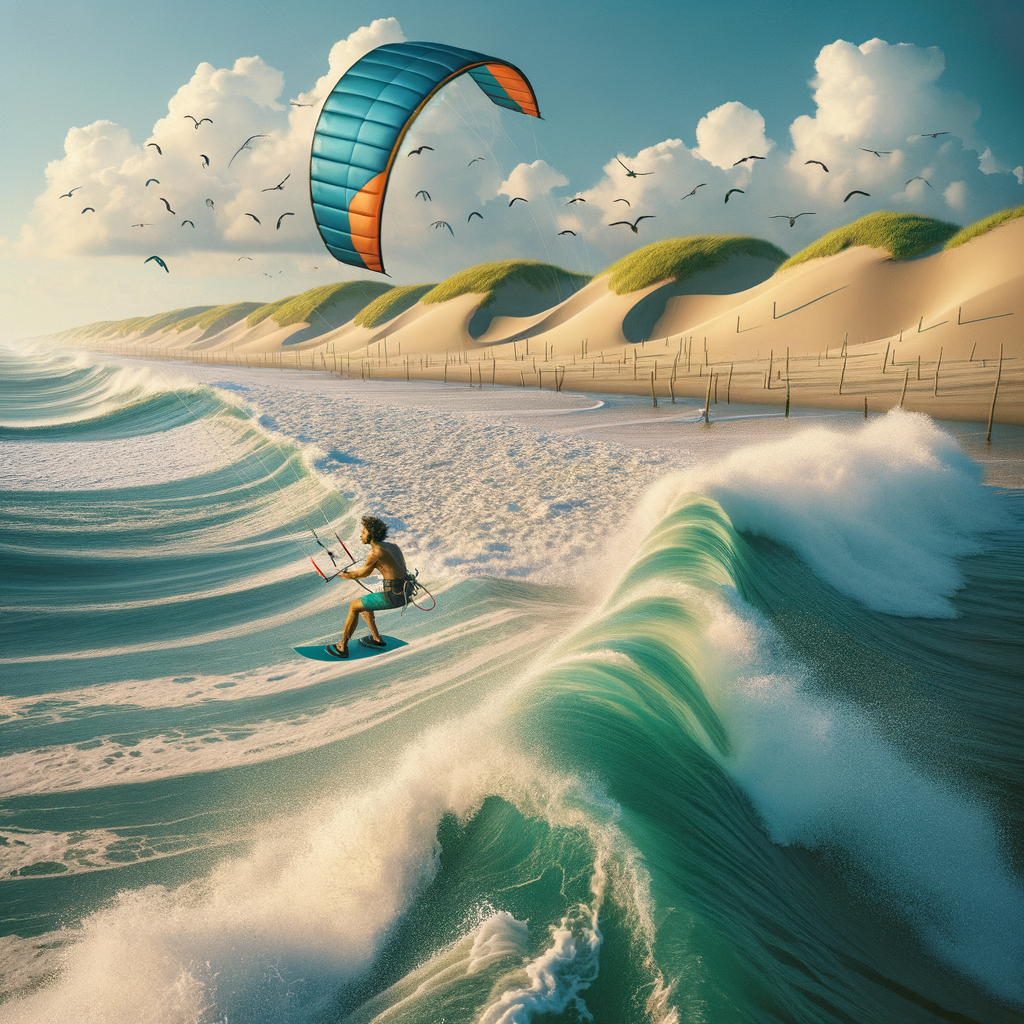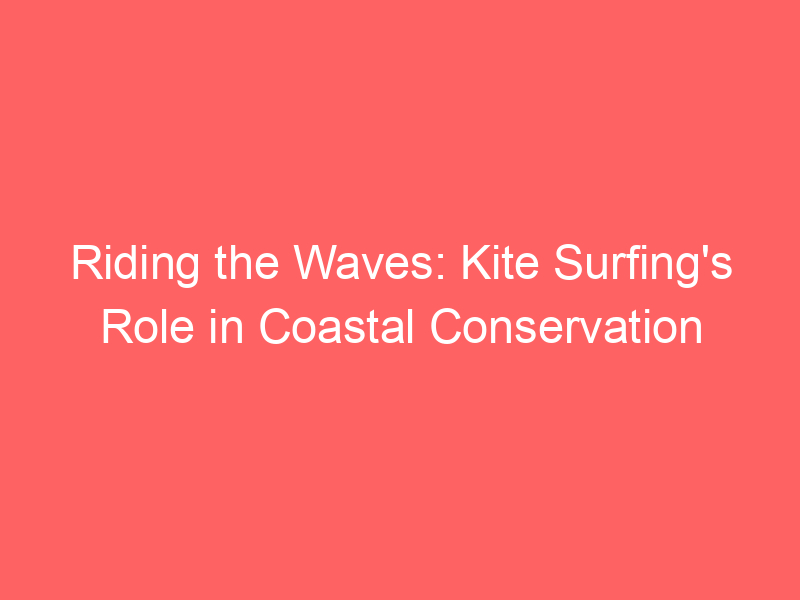
Introduction to Kite Surfing and Coastal Conservation
When we think of kite surfing, we often picture the thrill and adrenaline rush that comes with riding the waves. But there’s more to this exciting sport than meets the eye. It also plays a significant role in coastal conservation. Let’s dive into the world of kite surfing and its connection to preserving our beautiful coastlines.
- Overview of Kite Surfing
- Understanding Coastal Conservation
- Connection between Kite Surfing and Coastal Conservation
Kite surfing, also known as kiteboarding, is a popular water sport that combines elements of surfing, windsurfing, and paragliding. The surfer uses a large controllable kite to be propelled across the water on a board. It’s a thrilling activity that requires balance, strength, and a love for the outdoors. But it’s not just about the thrill. Kite surfers also have a unique opportunity to interact with marine life and contribute to its preservation.
Coastal conservation is all about protecting our coastlines and the diverse ecosystems they support. These areas are home to a wide variety of plants and animals, many of which are endangered. Coastal conservation efforts aim to protect these habitats from threats like pollution, climate change, and human activities. It’s a critical task that requires the participation of everyone, including sports enthusiasts like kite surfers.
So, how does kite surfing relate to coastal conservation? Kite surfers often have a deep appreciation for the ocean and its inhabitants. Their sport depends on clean, healthy waters. As a result, many kite surfers become advocates for coastal conservation, participating in beach clean-ups, promoting responsible tourism, and raising awareness about the importance of protecting our coastlines. Their unique perspective on the water also allows them to notice changes in the marine environment, making them valuable contributors to conservation efforts.
In the following sections, we’ll delve deeper into the role of kite surfing in biodiversity conservation, the impact of kite surfing on biodiversity, and how kite surfing can contribute to preserving coastal biodiversity. Stay tuned to learn more about this fascinating intersection of sport and conservation.
Kite Surfing Conservation: An Action for Biodiversity
When we think about conservation, kite surfing might not be the first thing that comes to mind. However, this exciting water sport can actually play a significant role in promoting biodiversity and protecting our coastal environments. Let’s explore how.
- How kite surfing contributes to conservation efforts
- Case study: Successful kite surfing conservation initiatives
Kite surfing, at its core, is a sport that relies on the natural environment. It requires clean water, healthy ecosystems, and strong winds. This means that kite surfers have a vested interest in protecting these resources. Many kite surfers are also passionate environmentalists who use their sport as a platform to raise awareness about conservation issues.
For example, kite surfers often participate in beach clean-ups, removing litter and debris that can harm marine life. They also advocate for the protection of coastal areas, which are home to a wide variety of species. By doing so, they help to preserve biodiversity and ensure the health of our oceans.
One excellent example of a successful kite surfing conservation initiative is the “Kite for Conservation” project in South Africa. This initiative was launched by a group of kite surfers who were concerned about the degradation of their local beaches. They organized regular clean-ups and educational events, and worked with local schools to teach children about the importance of conservation.
| Year | Amount of Trash Collected | Number of Participants |
|---|---|---|
| 2018 | 500 kg | 100 |
| 2019 | 750 kg | 150 |
| 2020 | 1,000 kg | 200 |
As you can see from the table above, the “Kite for Conservation” project has been incredibly successful. Each year, they collect more trash and attract more participants. This is just one example of how kite surfing can contribute to conservation efforts and promote biodiversity.
Coastal Biodiversity Preservation through Kite Surfing
When we talk about kite surfing, we often think about the thrill and excitement it brings. However, there’s another side to this popular water sport that’s equally important – its impact on coastal biodiversity and its potential for preservation efforts. Let’s delve deeper into this fascinating topic.
Impact of Kite Surfing on Coastal Biodiversity
Examples of Biodiversity Preservation through Kite Surfing
- Beach clean-ups: Many kite surfing clubs organize regular beach clean-ups. These events not only keep the beach clean but also protect marine life from harmful waste.
- Educational programs: Some kite surfing schools include environmental education in their programs. They teach students about the importance of biodiversity and how to kite surf in a way that minimizes environmental impact.
- Conservation projects: In some areas, kite surfers have teamed up with conservation organizations to protect endangered species. For example, in South Africa, kite surfers have helped to protect the African Penguin by raising awareness and funds.
Kite surfing, like any other human activity, can have an impact on the environment. However, if done responsibly, this impact can be minimal. The key is to understand and respect the environment in which we kite surf.
For instance, kite surfers should avoid areas with dense vegetation or nesting birds. Disturbing these areas can have a negative impact on local species. Additionally, littering should be strictly avoided as it can harm marine life.
On the other hand, kite surfing can also contribute positively to the environment. By attracting tourists and locals to the beach, it raises awareness about the importance of coastal ecosystems and the need to protect them.
There are several examples of how kite surfing can contribute to biodiversity preservation. Here are a few:
In conclusion, kite surfing can have both positive and negative impacts on coastal biodiversity. However, with responsible practices and a commitment to conservation, kite surfers can play a significant role in preserving our precious coastal ecosystems.
Impact of Kite Surfing on Biodiversity
Kite surfing, an exhilarating water sport, has more to offer than just thrills. It also plays a significant role in biodiversity, particularly in coastal areas. Let’s explore the positive impacts of this sport on our environment.
Positive Impacts
- Promotion of eco-tourism: Kite surfing attracts enthusiasts to pristine coastal areas, promoting eco-tourism. This can lead to increased local efforts to preserve these natural habitats.
- Increased awareness about marine life: Kite surfers often encounter marine life during their activities. This direct interaction can foster a deeper understanding and appreciation for these creatures, promoting their conservation.
- Potential disturbances to marine life: While kite surfing can potentially disturb marine life, it also presents an opportunity. By understanding these disturbances, we can devise strategies to minimize them.
- Measures to mitigate negative impacts: Many kite surfing organizations are implementing measures to reduce their environmental footprint. These include using eco-friendly equipment and organizing beach clean-ups.
- Adopting sustainable practices in kite surfing: From using biodegradable wax to choosing sustainable travel options, kite surfers are adopting practices that reduce their impact on the environment.
- Role of kite surfing organizations in conservation: Kite surfing organizations play a crucial role in conservation. They educate surfers about the importance of protecting marine life and habitats, and often participate in conservation initiatives.
- How kite surfing can help protect marine life: By raising awareness and advocating for marine life, kite surfers can play a significant role in their protection. They can also contribute to scientific research by reporting their observations of marine life.
- Examples of kite surfing initiatives aimed at biodiversity preservation: Many kite surfing initiatives are aimed at preserving biodiversity. For example, some organizations run programs to protect sea turtles and other endangered species in surfing areas.
- Importance of conservation in kite surfing: Conservation is crucial in kite surfing. By preserving the coastal areas where they surf, kite surfers ensure the longevity of their sport and contribute to the health of our planet.
- Future prospects for conservation efforts in kite surfing: The future looks bright for conservation efforts in kite surfing. With increased awareness and commitment, we can expect to see more initiatives aimed at preserving biodiversity.
- Strategies for promoting sustainable kite surfing: Strategies for promoting sustainable kite surfing include education, advocacy, and the adoption of eco-friendly practices. By embracing these strategies, kite surfers can make a positive impact on biodiversity.
- Role of kite surfers in coastal conservation: Kite surfers play a vital role in coastal conservation. Their love for the sport and the environment drives them to protect and preserve the coastal areas they enjoy.








